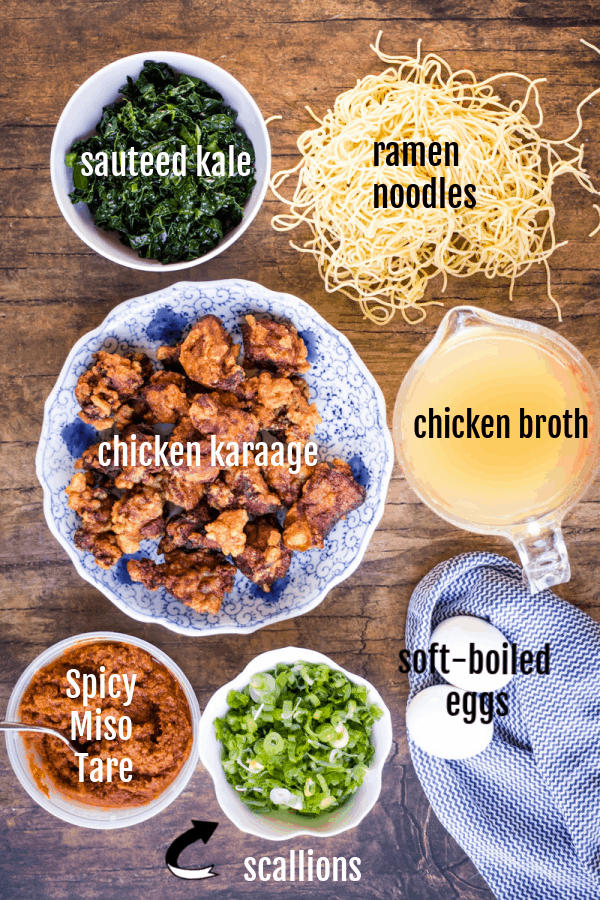Spicy Miso Ramen is rich and full of flavor. Top it with crunchy Chicken Karaage or Japanese Fried Chicken, sautéed kale, and a perfectly cooked soft-boiled ramen egg. It is a meal that will fill your belly and soothe your soul.

This post may contain affiliate links. As an Amazon Associate, I earn from qualifying purchases. See my Affiliate Disclosure.
Ramen is delicious, and it is also a fascinating cuisine. This is one of my favorite ramen recipes, and it comes from my new book Ramen for Beginners.
I got to study ramen recipes, the history of ramen, and the many different styles and nuances of how to make ramen when I coauthored the book Ramen Obsession last year.
This year I got lucky again when I got to explore easy recipes for homemade ramen in Ramen for Beginners
.
What is ramen?
The most fascinating about ramen is that it is born of a cuisine that places so much emphasis on tradition, but maintains the free spiritedness of the most modern cooking styles.
Ramen is not bound by tradition the way sushi and other Japanese sub-cuisines are.
Ramen (almost) always begins with broth, seasonings, and noodles. But beyond that, it is a freestyle adventure. The intent is to draw on local influences and available ingredients and appeal to different palates.
To call some ramen authentic or inauthentic is to do a disservice to the whole idea of ramen. It is a creative pursuit, open to interpretation and outside influences. That’s exactly why it has taken the world by storm to such a degree.
There are more than 10,000 ramen shops in Japan and countless more around the world. In addition to the more traditional Japanese toppings, you’ll find ramen topped with everything from pineapple to cheese, roasted tomatoes, duck confit, and pepperoncini.
Ramen for Beginners
Ramen for Beginners takes on the ramen creativity challenge, and it also keeps things super simple. The book has 90+ ramen recipes geared for beginners.
Some of my favorites are Shoyu Shrimp Tempura Ramen, Shio Ramen with Hoisin Beef, Tantenmen with Spicy Sesame Pork, and Cold Vegan Mazemen with Cucumbers and Sesame-Miso Dressing.
The book also includes step-by-step guidance on how to make broth, choose noodles, source ingredients, and assemble a perfect bowl of ramen.

What kind of noodles should you use?
You can’t have a bowl of ramen without noodles. Ramen noodles are wheat noodles that have been treated with an alkalinizing agent, called kansui, to give them their distinctive springy texture. They come in several forms: Fresh, dried, or instant.
Fresh ramen noodles are always my first choice because they cook up to the ideal chewy-tender texture and absorb the other flavors in the soup especially well.
If you have a Japanese market in your area, you can probably get great quality fresh or fresh frozen noodles there. If not, you might try asking your favorite ramen restaurant if they would sell you a bag of their noodles.
Dried ramen noodles take a bit longer to cook, but they are a great option if fresh noodles aren’t available. Look for them in the Asian food aisle in the supermarket or in any Asian market in the noodle aisle.
Instant ramen noodles are flash fried before packaging, which is what makes them cook so quickly.
I am not ashamed to admit that I always have a few packs of instant ramen in my pantry. They are quick and easy to make. Plus, my 12-year-old son can easily make himself a bowl on his own.
Our favorite instant ramen is Sapporo Ichiban Miso Ramen or any of the other flavors by Sapporo Ichiban.
Gluten-free noodles. Ramen noodles are wheat noodles by definition, but if you are on a gluten-free diet (or cooking for someone who is), you can substitute Asian rice noodles like Vietnamese rice vermicelli or Thai rice stick noodles.
You can buy rice noodles in most supermarkets, in the international food aisle, or in any Asian grocery.
How do you make a perfect ramen egg?
This question probably merits an entire blog post all to itself but I’m going to try to answer it here.
Soft-boiled eggs are one of the most common ramen toppings. Whether you are dressing up instant ramen at home or dining at a trendy ramen shop, you’ll likely to find a perfectly cooked soft-boiled egg adorning your bowl.
Here’s how to make a perfect ramen egg with a white that is set and a yolk that is still jammy:
- Fill a medium saucepan with water and bring to a boil over high heat. Reduce the heat to medium so that the water is simmering just below boiling. Using a slotted spoon, gently lower the eggs into the water. Simmer for 6 minutes.
- While the eggs are simmering, in a large bowl, place several ice cubes and add cold water to cover.
- When the eggs are finished cooking, pour off the hot water and run the cold water over them for a few minutes to cool them down. Transfer the eggs to the ice bath and let them sit for about 5 minutes, until they are completely cooled. Drain.
- To serve, carefully peel the eggs and slice them in half lengthwise.
You can keep ramen eggs in your refrigerator for up to 5 days. You can also marinate them in soy sauce, rice wine, and other ingredients to make Soy Sauce Eggs to top your ramen.
What ingredients do you need to make this spicy miso ramen recipe?
Most of the ingredients for this spicy miso ramen recipe are things you likely have on hand or can pick up at your regular supermarket. This is especially true if you have already made the Spicy Miso Tare and/or the Chicken Karaage.
- Spicy Miso Tare (miso paste, sesame paste, sesame oil, rice vinegar, and gochujang or chile paste)
- Noodles
- Chicken broth
- Kale
- Chicken Karaage (Chicken, soy sauce, sake or mirin, sesame oil, ginger, sugar, cooking oil for frying, and potato starch, cornstarch, or flour). You could substitute Air Fryer Pork Belly if you like!
- Soft boiled eggs
- Optional garnishes like scallions, sichimi togarashi, chili oil, sesame oil, etc.

How do you assemble a bowl of ramen?
Making ramen from scratch is easy. It just requires prepping several different elements.
The great thing is that many of the elements can be made ahead. You can have them ready to go whenever you’re ready for a steaming bowl of noodles and broth.
- First make your Spicy Miso Tare, Ramen Eggs, and Chicken Karaage.
- Next, heat the broth.
- Saute the kale.
- Spoon some tare to each bowl.
- Add a little bit of broth and stir it into the tare to start dissolving it.
- Divide the noodles between the bowls.
- Ladle broth over the noodles, then use chopsticks to stir everything together and pile the noodles up in the center of the bowl.
- Arrange the toppings—the kale, Chicken Karage, and egg—on top of the noodles.
- Garnish with scallions, sichimi togarashi, or other final touches.

Is homemade ramen healthy?
Instant ramen contains a lot of sodium and other additives. The noodles are also flash-fried, making them higher in fat and calories than fresh noodles cooked simply in boiling water. And of course, instant ramen packets don’t contain any vegetables or significant sources of protein.
When you make ramen at home, you can choose the most nutritious options. Start with a low-sodium broth and season it simple ingredients like soy sauce, miso paste, sesame oil, and rice wine.
When you get to topping your ramen, you can really bring a lot of nutrition to the mix. Top your homemade ramen with fresh vegetables, chicken, pork, tofu, edamame, fish or other seafood, seaweed, and soft boiled ramen eggs.
You can load it up with meaty toppings or make it vegetarian or vegan. You could substitute Mochiko Chicken for the Chicken Karaage, too. The best thing about homemade ramen is that you can tailor it to your own dietary needs and personal taste.

more japanese recipes you’ll love
If you love Japanese food try some Japanese snacks like Onigiri, Yaki Onigiri, Stir-Fried Lotus Root, or Chawanmushi.
For breakfast or brunch, try Japanese Souffle Pancakes with a nice cold Matcha Milk Tea!

Spicy Miso Ramen with Chicken Karaage
Ingredients
- 8 cups chicken broth
- 2 teaspoons sesame oil
- 8 ounces kale leaves center stems removed, and leaves sliced into ribbons
- 1/2 cup Spicy Miso Tare
- 18 ounces fresh ramen noodles 12 ounces dried ramen noodles, or 2 packages instant ramen noodles, cooked according to package directions
- Chicken Karaage
Instructions
- In a pot, heat the broth over medium-high heat until simmering.
- While the broth is heating, in a skillet, heat the sesame oil and sauté the kale for about 3 minutes, until it is softened
- Into each of 4 serving bowls, put 2 tablespoons of tare. Divide the noodles between the bowls and ladle broth over the noodles. Arrange the kale and chicken on top. Serve immediately



15 thoughts on “Spicy Miso Ramen with Chicken Karaage”